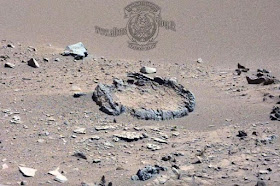Already the second stone circle falls into the lens of the NASA rover camera "Curiosity" (Mars Science Laboratory Curiosity). The first one was discovered last year by a virtual archaeologist, who was an advocate of Streetcap 1. Found among the pictures taken from Mars, laid out on the NASA website.
Circle discovered by virtual archaeologist Streetcap 1
The second round caught his colleague's eyes, who calls himself SecureTeam 10. It's obvious that the circles are different.
Streetcap 1 believes that "his" circle is exactly man-made - they say, someone for some reason put together the stones so fitted to each other. As proof, the "archaeologist" points to the stone in the foreground. I'm sure that he fell off.
The circles caught in the camera lens of "Curiosity" are small - no more than 2 meters in diameter. Their origin is indeed puzzling. It is unlikely that the Martian breed accidentally could lie so smoothly. Moreover, at least two times.But the idea that the Martians tried here does not look reasonable.
According to one of the most sound hypotheses, the circle was once a lava bubble. The top crumbled - left the ground. It cracked. And an illusion was created that the circle is made up of individual stones.
By the way, Mars has similar structures, but a much larger diameter. They were photographed in 2012 by NASA's automatic NASA's Mars Reconnaissance Orbiter station - the images were taken with a High Resolution Imaging Science Experiment (HiRISE) camera.
It can be seen that the craters did not hit the surface; convexities remained on the surface. It seems that these objects also appeared as a result of volcanic activity - they were first inflated with bubbles, frozen and finally collapsed, forming ring structures.
However, the version is "spoiled" by polyhedra, which are surrounded by straight rings. To ufologists they give the right to assert that these objects are man-made - they were built by ancient Martian nomads. Used as pens for cattle.
The circles caught in the camera lens of "Curiosity" are small - no more than 2 meters in diameter. Their origin is indeed puzzling. It is unlikely that the Martian breed accidentally could lie so smoothly. Moreover, at least two times.But the idea that the Martians tried here does not look reasonable.
According to one of the most sound hypotheses, the circle was once a lava bubble. The top crumbled - left the ground. It cracked. And an illusion was created that the circle is made up of individual stones.
By the way, Mars has similar structures, but a much larger diameter. They were photographed in 2012 by NASA's automatic NASA's Mars Reconnaissance Orbiter station - the images were taken with a High Resolution Imaging Science Experiment (HiRISE) camera.
It can be seen that the craters did not hit the surface; convexities remained on the surface. It seems that these objects also appeared as a result of volcanic activity - they were first inflated with bubbles, frozen and finally collapsed, forming ring structures.
These circles are photographed from orbit
However, the version is "spoiled" by polyhedra, which are surrounded by straight rings. To ufologists they give the right to assert that these objects are man-made - they were built by ancient Martian nomads. Used as pens for cattle.



